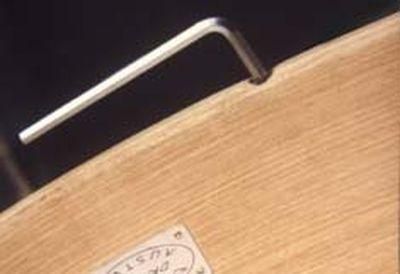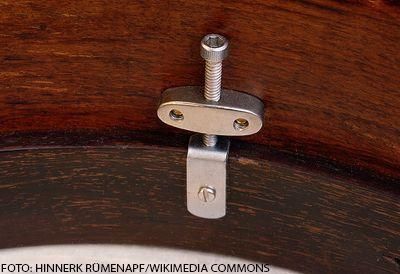Buyer's Guide
What not to buy?
Let's start with drums that cannot be recommended: Drums that come from unknown sources and drums that have industrial skins or frames. If you look into ebay and in some music shops (even in Ireland) you will often find drums that are imported from Far East countries that sell for 80€ or less. The skin is very hard most of the time and the drums are missing everything that you want even from a beginner's drum: nice bass, clear middle area and poppy high notes. Often you find a celtic design or a Guinness Logo on these "drums".
These are good enough to hang on a wall, but nothing else. Nobody knows where the skins come from and with which chemicals and under what circumstances (wages, keeping of the animals, working conditions etc.) they are produced. The problem is that even over in Ireland you might find this type of drum in shops that praise themselves highly. I have seen many disappointed faces during my workshops when people had a comparison to a quality drum that wasn't much more expensive than the cheap drums they bought. The sound and the tonal variation between the two differ that much.
What to buy?
But what characterises a quality drum?
A good sound, clean workmanship, long durability, playability in general (with some cheap drums the hand hardly fits under the cross).
There are certainly many factors that play a role, but the main thing is the head, the tuning system, the frame and the workmanship.
The skin
The majority of drums are made with goat skin, sometimes calf or kangaroo. Occasionally one will see emu, deer, even greyhound. The curing of the skin is something that takes time, which is reflected in the price.
Often chemicals are used to prepare the skin quickly, which can be avoided if you give the skin the time needed. The skin should be soft, not hard and scratchy. A painted skin is not recommend.
There are drums with tape on the outside to dampen some of the overtones. Sometimes the tape is replaced by a skin ring inside the drum. I personally prefer outside tape, since it gives more room for your opposing hand. Also, tape is easier to adjust to the individual sound of the skin and can be replaced easily if necessary.
The skin determines the sound of the bodhrán more than anything else. There are soft heads, crisp heads, thick heads, thin heads. All of them have a certain characteristic, which I have listed here in the description of the respective drum model.
Many heads need a certain break-in time, which can take up to half a year until the bodhráns reach their full potential. Nevertheless, the drums offered here sound very good out of the box (with the exception of TrHED, which needs a long break-in period).
The tuning system
I do not recommend non tunable drums due to the reaction of natural skins to temperature and humidity. Without a way to tighten or slacken the skin, the player is left with an unplayable drum, or one whose tonal range is severely limited. So, tuneable it is...

CH Tool-less System
The multipoint tuning system works smoothly and allows for precise, quick and easy tuning. Thanks to the skilful shaping of the inner part of the tuning rim, the hand nestles naturally into place and is therefore very comfortable to play.

CH compressor tuning system
The RWE features a tool-less tuning system. The compressor tuning frame is a funnel shaped, relatively high tuning rim, which influences the overtones and the overall frequencies of the bodhrán in a positive way.

Integrated tuning system
This system needs an Allen key and is integrated into the frame, therefore it doesn't need an additional tuning frame, which makes is a very slim system. Repairs may be more difficult as it is with all integrated systems.

classic system
Many drums feature this system using different screw heads. The screw pushes the inner rim down.
The frame
The rim should be made from high quality wood. It is important that there are no sharp edges and that the rim is stable.
The finish is not important where sound is concerned, but you want to have a drum that you like looking at :-).
The frame design (diameter and depth) has only a limited influence on the sound. A deeper frame compresses the sound somewhat and a shallower frame sounds more open. However, it is a common rumour that big drums have more bass. The diameter and also the depth of the frame are important mainly for playing comfort. Here, too, the obvious idea that tall people always need a big drum is not correct. Factors like arm length and playing technique also play a role. I am 2 m (6’6’’) tall, but I play a drum with a diameter of 37 cm, despite long arms.
A crossbar is no longer needed today. Often it is in the way and too close to the skin. A few players like a single crossbar, a strut with enough distance to the skin. This can help to put even more pressure on the head.
A cut out can be used for deep drums. However, this also has several disadvantages: On the one hand, the maker already determines how the player has to hold the drum and on the other hand, there are players who regularly turn their drums, which is also not possible with the cut out. I am not a fan of the cut-out myself, because a certain frame depth also brings stability when playing.
What else?
Where to buy?
The average music shop rarely has any quality bodhrans to try out. Our Show Room stocks all the Christian Hedwitschak drums and Stevie Moises tippers available. You are welcome to try out the various models before purchasing the one most suited to your needs. In addition workshops are good for trying out different drums. Usually you will also find accessories like sticks and bags there.
Most makers offer online ordering now or you are lucky and you have a good maker near you.
Order online?
Often, trying one out is not an option, but you can order through my shop and I will grant you a two-week grace period in which you can return anything for a full refund. But: I have sold more than 1000 drums and so far only one has been returned! This speaks for the high quality of drums made by Christian Hedwitschak! And we also make sure that the drums match the descriptions and try to deliver consistent characteristics.
YouTube, concerts, recordings
What you have heard on youtube, on recordings, in concerts etc. is the product of the drum sound, the players abilities, the miking, the mixing, the compression on youtube and your own speakers. So this can only reflect the actual sound of a drum to a limited extent.
Do you hear the difference of the different price ranges?
Yes, I did a double blind test with a bodhran course (18 participants) with different manufacturers and price classes (I play the drum, the students evaluated without seeing which drum I had in my hand, 2 rounds, then the average value of the evaluation was determined). In fact, the more expensive drums came out on top.
Who to ask?
Some links in the internet might be helpful. The German Bodhran Forum is a good start, but it's in German...good international ressources are the groups at Facebook.
So what should you buy?
The drums I prefer can be found in the shop.
I only sell drums that I am 100% convinced of and as a Hedwitschak Premium partner I am involved in development of most models.
I think Christian's drums are the best on the market. Christian also sets a high value on short ways of transport, fair deals with suppliers and resellers (me!), and chooses environmentally sustainable materials.
That doesn't mean that the other makers are making bad drums!
Here is a list of some other drum makers: Seamus O'Kane, Diarmaid O'Kane, Ben March, Michael Vignoles, Alberto Alfonso, Brendan White, Brendan de Faoite, Seanie McGrath, Robert Forkner,Davy Stuart, Victor Barral, Mance Grady, Beagan drums, Finnegan Hill Percussion or Norbert Eckermann. (I am sure I forgot someone in this list, so it might not be complete!).
Read more
For more information on Christian Hedwitschak's bodhráns, the different series and the philosophy behind them, please read on here:
For more information on Stevie Moises' tippers, the different series and the philosophy behind them, please read on here:
For more information on the woods used in tippermaking, please read on here:
For more information on how we can achieve different sounds, please read on here:
For more information on drum heads and their interaction with tippers, please read on here:

